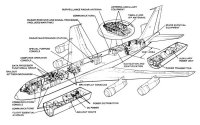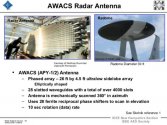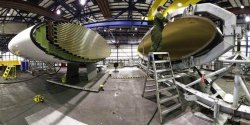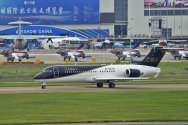Hasn't the E-3 been continually upgraded throughout its service life? It might be older, but is it necessarily the most obsolete out of the line-up here?
The variant currently used by USAF is E-3G (Block 40/45) which is an upgrade. Total of 24 E-3G were modernized in 2014-2020 from 14 E-3B (Block 30) and 10 E-3C (Block 35). Those in turn were 1970/80s design and build. The E-3G is a temporary solution and will be replaced by 26 E-7.
The computers were replaced with new open-architecture environment but E-3G still uses AN/APY-1 (upg. E-3B) or AN/APY-2 (upg. E-3C) radar which consists of a single rotating PESA antenna. The antenna introduces a physical limit on how much information the radar can acquire no matter how modern the rest of the system is.



E-2D introduced in 2010 uses AN/APY-9 which is a new radar with a single rotating AESA antenna in UHF band for detection of LO/VLO airframes.
KJ-200 is also quite modern but also less capable than KJ-500 with the limitation that its primary array only has side coverage (though possibly mitigated by upgrades that give it nose and tail arrays to provide it with technically there 360 degree coverage).
The difference in coverage between a system with two antennas with side view and three antennas with 360deg coverage is mostly important for naval operations. Air force AEW typically operates alongside ground force deployment which means that it follows a
front that separates controlled/own airspace from contested/enemy airspace. That means that a patrolling AWACS flies along a pre-determined path parallel with blind-spots mostly emerging during turns. Naval AEW typically operates in international waters where all airspace is considered contested unless control of waters is established allowing the creation of a maritime "front". I think this is the main reason why KJ-500 has a more expensive three-sided antenna. This allows KJ-500 to be used in both land and maritime domains while KJ-200 will have limitations at sea and will be most suitable for land theaters where flanks can be defended by other sensors/SAMs.
If, as you say, more KJ-200 or another simpler two-sided antenna AWACS are procured they will most likely be intended for operations over land or for protection of own territory.
As far as AEW&C capability to fighter ratios go, the PLA is in a pretty decent spot globally, and they are continuing to build KJ-500s and there are signs they are going to be building more KJ-200s as well.
PLAAF has potentially already achieved better AEW/fighter ratio than USAF.
USN AEW provides up to 75% of total AEW capabilities and while in WestPac theater USN and USAF will operate jointly USN AWACS is fundamental to carrier operations which means that they are limited by carrier deployment. Combined with land-based operations for USAF it will create unavoidable gaps in coverage. That is likely to shift the odds in PLA's favour even further, especially as AWACS production continues.
In the medium term future onwards it's likely they will supplement and augment their manned AEW&C fleet with AEW UAVs, and it's possible a Y-20 based AEW&C could be procured in small numbers eventually a new manned AEW&C possibly based on a domesticated C919 airframe will emerge.
Are there any credible rumours of Y-20 being developed as AEW platform?
USSR developed A-50 from Il-76 because they didn't have any other design capable of carrying the antenna. The equivalent Soviet passenger aircraft was Il-62 which had a narrow body and twin paired engines at the tail as well manual controls. Consequently it couldn't carry a heavy radome. Americans had a stroke of luck with B707 which turned out to be the optimal airliner design that was copied by all later designs like B737 and Airbus A300.
The platform has two specific tasks - it has to fit the crew, equipment and carry the radar and it has to be able to cover a specified distance. Modern radar and computer technology allows medium-sized airframes to perform as well as larger airframes. The ability to carry mass over long distances is another matter so the only scenario where a Y-20 AWACS could be viable are some long-range missions in the Pacific. But those are not practical unless there are sufficient aerial refueling aircraft for whatever is to accompany the AWACS in which case KJ-500 is just as capable as long as it is capable of aerial refueling.
Perhaps Y-20 will be used for a longer-wave AEW system? Size of the antenna is determined by operating wavelength so if PLA wanted to develop low-frequency AEW a heavy airframe like Y-20 could be optimal.
Comparing USAF and USN fleets to the PLA total fleets is difficult because of how different the categories are.
E-3 and KJ-2000 are somewhat traditional large airframe AEW&Cs
KJ-500 and KJ-200 are medium airframe AEW&Cs
E-2 are small airframe AEW&Cs optimized for (and also somewhat limited by) carrier deck operations
AEW essentially are divided into land-based and ship-based which means large and small AWACS. There really isn't a meaningful difference between "traditional large" and "medium" airframe AWACS other than in endurance or capacity to handle tasks due to crew limitations. Land-based AWACS with larger crews can control greater numbers of own aircraft. Carrier-based AWACS must be as small as possible and has therefore very limited capacity and endurance because of small crew. However the purpose of shipborne AEW is to serve as mobile high-altitude radar antenna for the carrier and the task force. They don't have to deal with formations of tens or hundreds of aircraft and they usually don't stay in the air for as long as land-based AWACS do.




